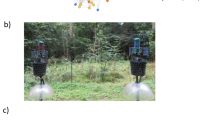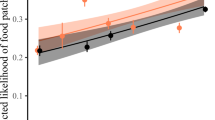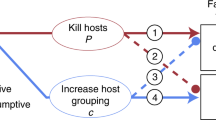Abstract
Social predation—the act of hunting and feeding with others—is one of the most successful life-history traits in the animal kingdom. Although many predators hunt and feed together, a diversity of mechanisms exist by which individuals forage socially. However, a comprehensive framework capturing this diversity is lacking, preventing us from better understanding cooperative forms of predation, and how such behaviours have evolved and been maintained over time. We outline a framework of social predation that describes five key behavioural dimensions: sociality, communication, specialization, resource sharing, and dependence. By reviewing examples of social predation, we demonstrate the strength of a multidimensional approach, highlighting key commonalities and differences among species, and informative cross-dimensional correlations. These patterns highlight different potential evolutionary pathways and end-points across a multidimensional social predation spectrum.
This is a preview of subscription content, access via your institution
Access options
Access Nature and 54 other Nature Portfolio journals
Get Nature+, our best-value online-access subscription
$29.99 / 30 days
cancel any time
Subscribe to this journal
Receive 12 digital issues and online access to articles
$119.00 per year
only $9.92 per issue
Buy this article
- Purchase on Springer Link
- Instant access to full article PDF
Prices may be subject to local taxes which are calculated during checkout


Similar content being viewed by others
References
Pitcher, T. J. et al. Fish in larger shoals find food faster. Behav. Ecol. Sociobiol. 10, 149–151 (1982).
Creel, S. Cooperative hunting and group size: assumptions and currencies. Anim. Behav. 54, 1319–1124 (1997).
Luhrs, M. L. et al. Strength in numbers: males in a carnivore grow bigger when they associate and hunt cooperatively. Behav. Ecol. 24, 21–28 (2012).
MacNulty, D. R. et al. Influence of group size on the success of wolves hunting bison. PLoS ONE 9, e112884 (2014).
Macdonald, D. W. The ecology of carnivore social behaviour. Nature 301, 379–384 (1983).
Krause, J. & Ruxton, G. D. Living in Groups (Oxford Univ. Press, Oxford, 2002).
Schaller, G. B. The Serengeti Lion: a Study of Predator–Prey Relations (Univ. Chicago Press, Chicago, 2009).
Packer, C. & Ruttan, L. The evolution of cooperative hunting. Am. Nat. 132, 159–198 (1988).
Dawkins, R. & Krebs, J. R. Arms races between and within species. Proc. R. Soc. Lond. B 205, 489–511 (1979).
Clutton-Brock, T. Cooperation between non-kin in animal societies. Nature 462, 51–57 (2009).
Bshary, R. et al. Interspecific communicative and coordinated hunting between groupers and giant moray eels in the Red Sea. PLoS Biol. 4, e431 (2006).
Hebshi, A. J. et al. Associations between seabirds and subsurface predators around Oahu, Hawaii. Aquat. Biol. 19, 89–98 (2008).
Elliser, C. R. & Herzing, D. L. Long-term interspecies association patterns of Atlantic bottlenose dolphins, Tursiops truncatus, and Atlantic spotted dolphins, Stenella frontalis, in the Bahamas. Mar. Mamm. Sci. 32, 38–56 (2016).
Beauchamp, G. Social Predation: How Group Living Benefits Predators and Prey (Elsevier, Amsterdam and Boston, 2013).
Boesch, C. & Boesch, H. Hunting behavior of wild chimpanzees in the Taï National Park. Am. J. Phys. Anthropol. 78, 547–573 (1989).
Ellis, D. H. et al. Social foraging classes in raptorial birds. BioScience 43, 14–20 (1993).
Bailey, I. et al. Group hunting within the Carnivora: physiological, cognitive and environmental influences on strategy and cooperation. Behav. Ecol. Sociobiol. 67, 1–17 (2012).
Kruuk, H. The Spotted Hyena: a Study of Predation and Social Behavior (Univ. Chicago Press, Chicago, 1972).
Busse, C. D. Do chimpanzees hunt cooperatively? Am. Nat. 112, 767–770 (1978).
Goodall, J. The Chimpanzees of Gombe: Patterns of Behavior (Belknap, Cambridge, MA, 1986).
Lonnstedt, O. M. et al. Lionfish predators use flared fin displays to initiate cooperative hunting. Biol. Lett. 10, 20140281 (2014).
Muro, C. et al. Wolf-pack (Canis lupus) hunting strategies emerge from simple rules in computational simulations. Behav. Processes 88, 192–197 (2011).
Marsh, S. L. Fish fauna observations at the Kermadec Island Group (NZ). TANE 31, 145–153 (1985).
Nowak, S. et al. Howling activity of free-ranging wolves (Canis lupus) in the Białowieża Primeval Forest and the Western Beskidy Mountains (Poland). J. Ethol. 25, 231–237 (2006).
Sumpter, D. J. The principles of collective animal behaviour. Philos. Trans. R. Soc. Lond. B 361, 5–22 (2006).
Sunquist, M. E. The Social Organization of Tigers (Panthera tigris) in Royal Chitawan National Park, Nepal. (Smithsonian Institution Press, Washington DC, 1981).
Eklöv, P. Group foraging versus solitary foraging efficiency in piscivorous predators: the perch, Perca fluviatilis, and pike, Esox lucius, patterns. Anim. Behav. 44, 313–326 (1992).
Newton, I. The Sparrowhawk (A&C Black, London, 2010).
Deacy, W. et al. Kodiak brown bears surf the salmon red wave: direct evidence from GPS collared individuals. Ecology 97, 1091–1098 (2016).
Clark, C. W. & Mangel, M. The evolutionary advantages of group foraging. Theor. Popul. Biol. 30, 45–75 (1986).
Silk, M. J. et al. The importance of fission–fusion social group dynamics in birds. Ibis 156, 701–715 (2014).
Wilson, R. P. et al. Group size in foraging African penguins (Spheniscus demersus). Ethology 72, 338–341 (1986).
Takahashi, A. et al. Synchronous diving behavior of Adélie penguins. Journal of Ethology 22, 5–11 (2004).
Queiroz, H. & Magurran, A. E. Safety in numbers? Shoaling behaviour of the Amazonian red-bellied piranha. Biol. Lett. 1, 155–157 (2005).
Dugatkin, L. A. The evolution of cooperation. BioScience 47, 355–362 (1997).
Whitehead, H. Formations of foraging sperm whales, Physeter macrocephalus, off the Galapagos Islands. Can. J. Zool. 67, 2131–2139 (1989).
Gordon, J. C. D. The Behaviour and Ecology of Sperm Whales off Sri Lanka PhD thesis, Univ. Cambridge (1987).
Whitehead, H. & Arnbom, T. Social organization of sperm whales off the Galapagos Islands, February–April 1985. Can. J. Zool. 65, 913–919 (1987).
Scheel, D. & Packer, C. Group hunting behaviour of lions: a search for cooperation. Anim. Behav. 41, 697–709 (1991).
Boesch, C. Cooperative hunting in wild chimpanzees. Anim. Behav. 48, 653–667 (1994).
Funston, P. et al. Factors affecting the hunting success of male and female lions in the Kruger National Park. J. Zool. 253, 419–431 (2001).
Funston, P. J. et al. Hunting by male lions: ecological influences and socioecological implications. Anim. Behav. 56, 1333–1345 (1998).
Berdahl, A. et al. Emergent sensing of complex environments by mobile animal groups. Science 339, 574–576 (2013).
Arganda, S. et al. A common rule for decision making in animal collectives across species. Proc. Natl Acad. Sci. USA 109, 20508–20513 (2012).
Herbert-Read, J. Understanding how animal groups achieve coordinated movement. J. Exp. Biol. 219, 2971–2983 (2016).
Krebs, J. R. Colonial nesting and social feeding as strategies for exploiting food resources in the Great Blue Heron (Ardea herodias). Behaviour 51, 99–134 (1974).
Anderson, J. G. T. Foraging behavior of the American white pelican (Pelecanus erythrorhyncos) in western Nevada. Colon. Waterbirds 14, 166–172 (1991).
Greene, E. Individuals in an osprey colony discriminate between high and low quality information. Nature 329, 239–241 (1987).
Dechmann, D. K. et al. Group hunting—a reason for sociality in molossid bats? PLoS ONE 5, e9012 (2010).
Brown, C. R. et al. Food-sharing signals among socially foraging cliff swallows. Anim. Behav. 42, 551–564 (1991).
Lima, S. L. & Dill, L. M. Behavioral decisions made under the risk of predation: a review and prospectus. Can. J. Zool. 68, 619–640 (1990).
Clay, Z. et al. Food-associated vocalizations in mammals and birds: what do these calls really mean? Anim. Behav. 83, 323–330 (2012).
Fox, M. W. The Whistling Hunters: Field Studies of the Asiatic Wild Dog (Cuon alpinus) (SUNY Press, New York, 1984).
Arnegard, M. E. & Carlson, B. A. Electric organ discharge patterns during group hunting by a mormyrid fish. Proc. Biol. Sci. 272, 1305–1314 (2005).
Creel, S. & Creel, N. M. Communal hunting and pack size in African wild dogs. Lycaon pictus. Anim. Behav. 50, 1325–1339 (1995).
Vail, A. L. et al. Referential gestures in fish collaborative hunting. Nat. Commun. 4, 1765 (2013).
Pooley, A. C. & Gans, C. The Nile crocodile. Sci. Am. 234, 1140 (1976).
Lukeman, R. et al. Inferring individual rules from collective behavior. Proc. Natl Acad. Sci. USA 107, 12576–12580 (2010).
Schmitt, R. J. & Strand, S. W. Cooperative Foraging by Yellowtail, Seriola lalandei (Carangidae), on Two Species of Fish Prey. Copeia 1982, 714–717 (1982).
Partridge, B. L. et al. The structure of schools of giant bluefin tuna in Cape Cod Bay. Environ. Biol. Fishes 9, 253–262 (1983).
Benoit-Bird, K. J. & Au, W. W. Cooperative prey herding by the pelagic dolphin. Stenella longirostris. J. Acoust. Soc. Am. 125, 125–137 (2009).
Handegard, N. O. et al. The dynamics of coordinated group hunting and collective information transfer among schooling prey. Curr. Biol. 22, 1213–1217 (2012).
Bednarz, J. C. Cooperative hunting Harris’ hawks (Parabuteo unicinctus). Science 239, 1525–1527 (1988).
Gazda, S. K. et al. A division of labour with role specialization in group-hunting bottlenose dolphins (Tursiops truncatus) off Cedar Key, Florida. Proc. Biol. Sci. 272, 135–140 (2005).
Stander, P. E. Cooperative hunting in lions: the role of the individual. Behav. Ecol. Sociobiol. 29, 445–454 (1992).
Boesch, C. Cooperative hunting roles among Tai chimpanzees. Human Nature 13, 27–46 (2002).
Kurvers, R. H. J. M. et al. The evolution of lateralization in group hunting sailfish. Curr. Biol. 27, 521–526 (2017).
Coscarella, M. A. et al. Short note: technique used by killer whales (Orcinus orca) when hunting for dolphins in Patagonia, Argentina. Aquat. Mamm. 41, 192–197 (2015).
Herbert-Read, J. E. et al. Proto-cooperation: group hunting sailfish improve hunting success by alternating attacks on grouping prey. Proc. R. Soc. B 283, 20161671 (2016).
Thiebault, A. et al. How to capture fish in a school? Effect of successive predator attacks on seabird feeding success. J. Anim. Ecol. 85, 157–167 (2016).
Holekamp, K. E. & Smale, L. Provisioning and food sharing by lactating spotted hyenas, Crocuta crocuta (Mammalia: Hyaenidae). Ethology 86, 191–202 (1990).
Janson, C. Aggressive competition and individual food consumption in wild brown capuchin monkeys (Cebus apella). Behav. Ecol. Sociobiol. 18, 125–138 (1985).
Alvard, M. S. Kinship, lineage, and an evolutionary perspective on cooperative hunting groups in Indonesia. Hum. Nat. 14, 129–163 (2003).
Wright, B. M. et al. Kin-directed food sharing promotes lifetime natal philopatry of both sexes in a population of fish-eating killer whales. Orcinus orca. Anim. Behav. 115, 81–95 (2016).
Spikins, P. et al. The cradle of thought: growth, learning, play and attachment in Neanderthal children. Oxf. J. Archaeol. 33, 111–134 (2014).
Wiley, D. et al. Underwater components of humpback whale bubble-net feeding behaviour. Behaviour 148, 575–602 (2011).
Yosef, R. & Yosef, N. Cooperative hunting in brown-necked raven (Corvus rufficollis) on Egyptian mastigure (Uromastyx aegyptius). J. Ethol. 28, 385–388 (2009).
Hill, K. & Hurtado, A. M. Cooperative breeding in South American hunter-gatherers. Proc. Biol. Sci. 276, 3863–3870 (2009).
Moffett, M. W. Foraging dynamics in the group-hunting myrmicine ant, Pheidologeton diversus. J. Insect Behav. 1, 309–331 (1988).
Maaten, L. v. d. & Hinton, G. Visualizing data using t-SNE. J. Mach. Learn. Res. 9, 2579–2605 (2008).
Fraley, C. et al. Normal Mixture Modeling for Model-Based Clustering, Classification, and Density Estimation Technical Report No. 597 (Dept. Statistics, Univ. Washington, 2012).
Au, D. W. & Pitman, R. L. in Seabirds and Other Marine Vertebrates (ed. Burger, J.) 174–212 (Columbia Univ. Press, New York, 1988).
Venkataraman, V. V. et al. Solitary Ethiopian wolves increase predation success on rodents when among grazing gelada monkey herds. J. Mammal. 96, 129–137 (2015).
Spottiswoode, C. N. et al. Reciprocal signaling in honeyguide-human mutualism. Science 353, 387–389 (2016).
Minta, S. C. et al. Hunting associations between badgers (Taxidea taxus) and coyotes (Canis latrans). J. Mammal. 73, 814–820 (1992).
Kays, R. et al. Terrestrial animal tracking as an eye on life and planet. Science 348, aaa2478 (2015).
Strandburg-Peshkin, A. et al. Shared decision-making drives collective movement in wild baboons. Science 348, 1358–1361 (2015).
Hubel, T. Y. et al. Additive opportunistic capture explains group hunting benefits in African wild dogs. Nat. Commun. 7, 11033 (2016).
Ford, A. T. et al. Large carnivores make savanna tree communities less thorny. Science 346, 346–349 (2014).
Firth, J. A. et al. Pathways of information transmission among wild songbirds follow experimentally imposed changes in social foraging structure. Biol. Lett. 12, 20160144 (2016).
Christie, K. S. et al. Unmanned aircraft systems in wildlife research: current and future applications of a transformative technology. Front. Ecol. Environ. 14, 241–251 (2016).
Harvey, R. J. et al. Determining position, velocity and acceleration of free-ranging animals with a low-cost unmanned aerial system. J. Exp. Biol. https://doi.org/10.1242/jeb.139022 (2016).
Durban, J. et al. Photogrammetry of killer whales using a small hexacopter launched at sea. J. Unmanned Veh. Syst. 3, 131–135 (2015).
Williams, T. M. et al. Instantaneous energetics of puma kills reveal advantage of felid sneak attacks. Science 346, 81–85 (2014).
Wilson, R. P. et al. Mass enhances speed but diminishes turn capacity in terrestrial pursuit predators. eLife 4, e06487 (2015).
Mech, L. D. & Boitani, L. Wolves: Behavior, Ecology, and Conservation (Univ. Chicago Press, Chicago, 2010).
Foote, A. D. et al. Genome-culture coevolution promotes rapid divergence of killer whale ecotypes. Nat. Commun. 7, 11693 (2016).
Biro, D. et al. Bringing a time-depth perspective to collective animal behaviour. Trends Ecol. Evol. 31, 550–562 (2016).
Acknowledgements
We thank J. Graving for suggesting the use of t-SNE to visualize the clustering of data points, and for providing code for this. We also thank the Farine lab for input during conception of the framework, K. McMahon and F. Hilleman for acting as independent scorers, and R. Kurvers, J. Herbert-Read, G. Ruxton, A. Wilkins and R. Ydenberg for providing valuable feedback on previous versions of this manuscript. This work was funded by the Max Planck Society. S.D.J.L. received additional funding from the DAAD (Deutscher Akademischer Austauschdienst).
Author information
Authors and Affiliations
Contributions
S.D.J.L. conceived the original idea and collated all data used in analyses. S.D.J.L. and D.R.F. outlined the framework, conducted the statistical analyses, and wrote the manuscript.
Corresponding authors
Ethics declarations
Competing interests
The authors declare no competing financial interests.
Additional information
Publisher’s note: Springer Nature remains neutral with regard to jurisdictional claims in published maps and institutional affiliations.
Electronic supplementary material
Supplementary Information
Supplementary Methods, Supplementary Figures 1–3, Supplementary Tables 1–4, Supplementary References
Supplementary Data
The full dataset contains the scoring for 77 different animal groups using our framework (main text Figure 1) and scoring using frameworks by Boesch & Boesch (1989), Ellis (1993), and Bailey (2012). For several species, evidence was obtained from more than one source. A full species list with references for each Supplementary Dataset is included in Supplementary Table 4
Rights and permissions
About this article
Cite this article
Lang, S.D.J., Farine, D.R. A multidimensional framework for studying social predation strategies. Nat Ecol Evol 1, 1230–1239 (2017). https://doi.org/10.1038/s41559-017-0245-0
Received:
Accepted:
Published:
Issue Date:
DOI: https://doi.org/10.1038/s41559-017-0245-0
This article is cited by
-
Dynamics of stability, bifurcation and control for a commensal symbiosis model
International Journal of Dynamics and Control (2024)
-
Interspecific foraging association of a nurse shark (Ginglymostoma cirratum) with bottlenose dolphins (Tursiops truncatus)
Animal Biotelemetry (2022)
-
Mechanisms of prey division in striped marlin, a marine group hunting predator
Communications Biology (2022)
-
Spatial clustering of trumpetfish shadowing behaviour in the Caribbean Sea revealed by citizen science
Marine Biology (2022)



